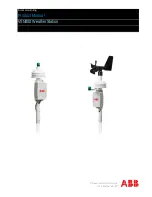
18
Rain
•
Make sure that the rain sensor is level. Look inside; there is a built-in level to assist in mounting. Make sure the
bubble is centered in the level.
•
Place the protective screen over the top to protect the rain sensor from the debris.
•
Where practical, mount the rain sensor in place with wood screws (not included).
•
Make sure that the rain sensor is in open area where precipitation falls directly into the sensor’s bucket, ideally 3-6
feet above the ground.
Note:
The rain sensor will need to be cleaned of debris on a regular basis. Mount in an accessible area.
•
The rain sensor should be placed in an open area away from the walls, fences, trees and other coverings
this may reduce the amount of rain falling into the bucket. Additionally, trees and rooftops may be sources
of pollen and debris that may clog the rain sensor.
•
To avoid the rain shadow effects, place the rain sensor horizontally, at a distance about two to four times the height of
any nearby obstruction.
•
Be aware of other wireless rain gauges in the area that may cause interference.
•
The Rain Gauge is self-emptying and can be left out all year or stored in the winter. If stored for the winter, remove the
batteries to avoid leakage.
Thermo-hygro
•
The remote thermo-hygro sensor should be placed in the area with a free air circulation and sheltered from direct
sunlight and an extreme weather conditions.
•
While the thermo-hygro sensor is weather resistant, avoid submersion in water or snow.
•
We recommend that you mount the outdoor temperature sensor on an outside North-facing wall.
•
The remote thermo-hygro sensor can stand vertically on a flat surface or mounted on the wall in vertical position
•
Use screws when mounting the thermo-hygro sensor on the wall
•
Avoid placing the thermo-hygro sensor near sources of heat such as chimneys and heating elements.
•
Avoid areas that collect or radiate heat from the sun, such as metal, brick/concrete structures, paving or patio decks.
Position the Weather Station
•
Make sure that the weather station is locating within the operating range of all remote sensors.
•
Mount the remote sensors within the line of sight of the weather station.
•
Transmission range may be affected by trees, metal structures and electronic appliances.
•
Test reception before permanently mounting all the remote sensors.
•
Mount near an exterior wall with the front or back facing toward Ft. Collins, Colorado for best WWVB reception.
Avoid placing the weather station in the following areas:
•
Direct sunlight and surfaces emitting and radiating heat, such as heating ducts or air conditioners.
•
Areas with interference from the wireless devices (such as cordless phones, radio headsets, baby listening devices,
etc.) and electronic appliances.
Care and Maintenance
•
Do Not Mix Old and New Batteries
•
Do Not Mix Alkaline, Standard, Lithium or Rechargeable Batteries
•
Do not immerse the sensors or weather station in water.
•
Do not clean the sensors or weather station with abrasive or corrosive materials that might scratch plastic parts or
corrode electronic circuits.
•
Do not subject the sensors or weather station to excessive force, shock, dust, temperature, or humidity, which may
result in malfunctions, shorter lifespan, damaged batteries, and damaged parts.
•
Do not tamper with the product’s internal components. Doing so will invalidate the warranty and may cause damage.
•
The product contains no user-serviceable parts.
•
Read the user's manual thoroughly before operating the product.





































